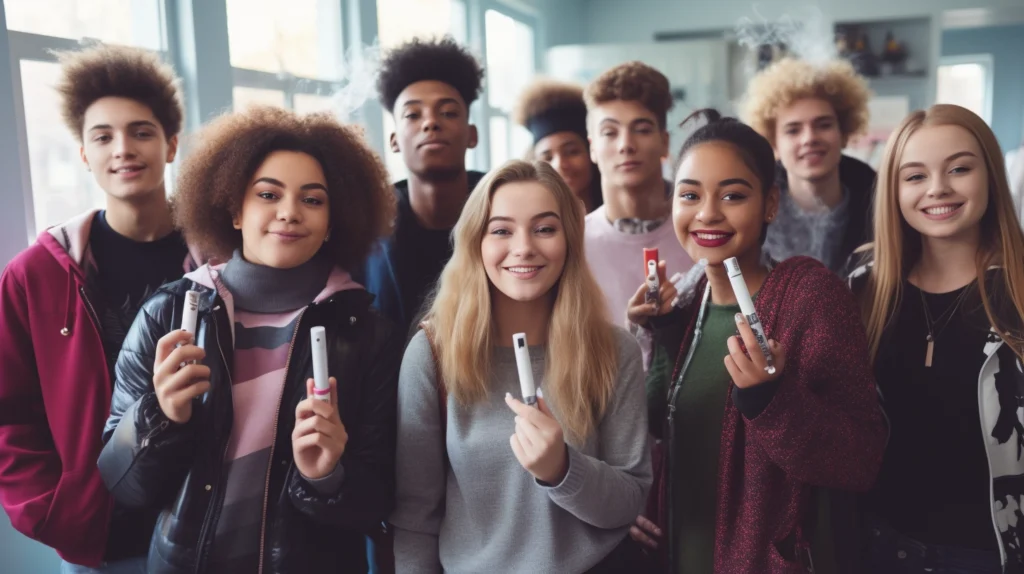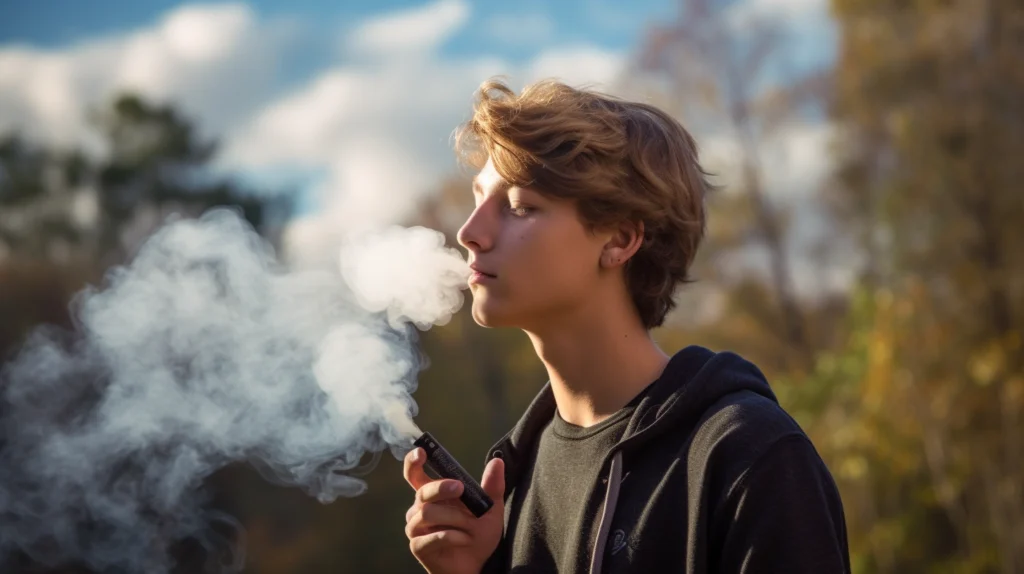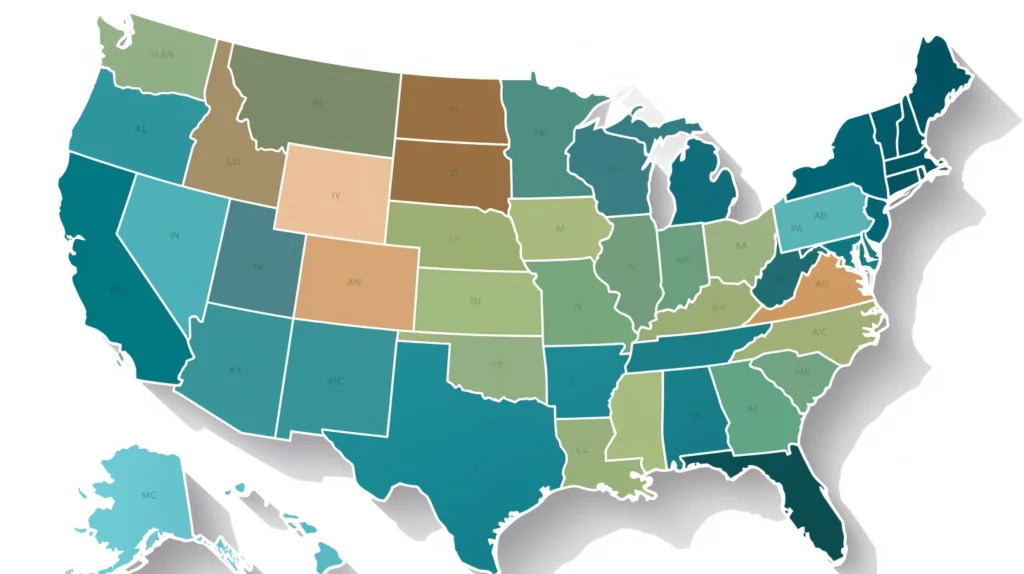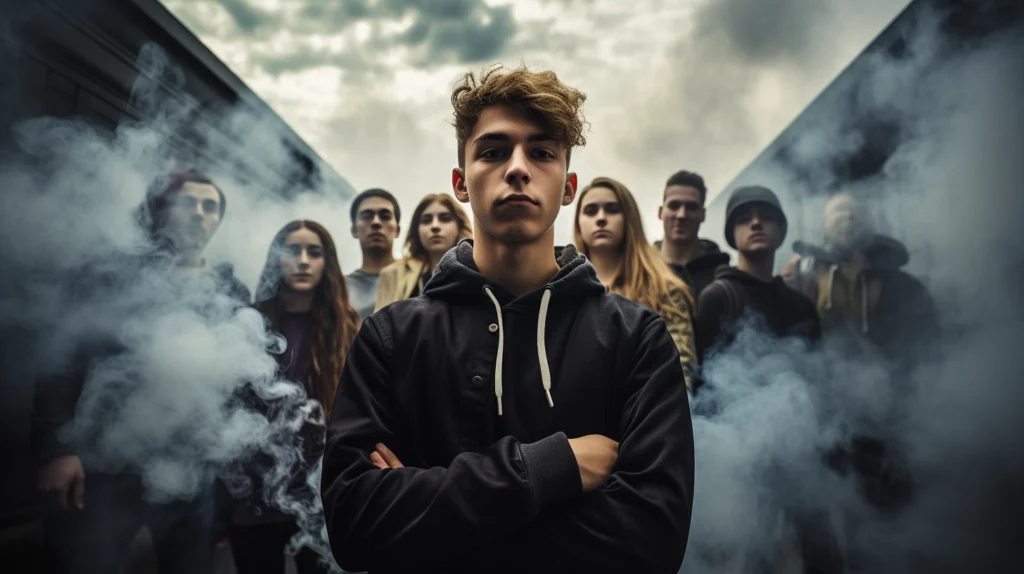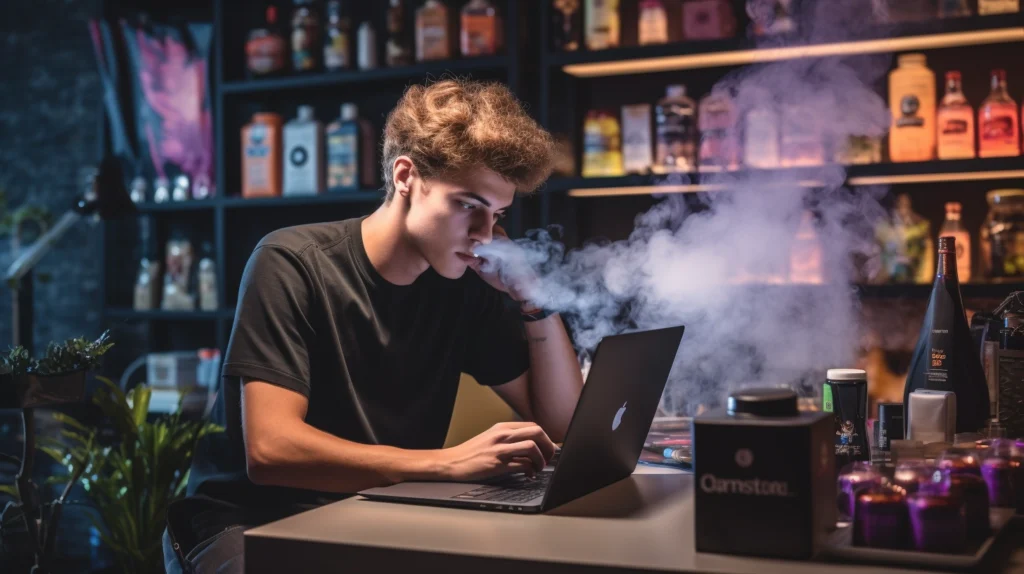Can You Go to Jail for Vaping at 13?
Introduction to Vaping and its Prevalence Among Teenagers
Vaping, the act of inhaling vapor produced by an electronic cigarette or similar device, has become a significant public health concern, particularly among teenagers. Recent statistics paint a concerning picture: a study conducted in 2023 revealed that approximately 20% of high school students have tried vaping at least once, and 5% are regular users. This trend is not just limited to high school students; middle schoolers are also increasingly experimenting with vaping, with around 7% having tried it.
The reasons behind this surge in vaping among teenagers are multifaceted. Firstly, the marketing of vaping products often targets a younger audience. Flavors like bubblegum, strawberry, and mint make these products more appealing to teenagers, who may view them as less harmful or more socially acceptable than traditional cigarettes. Additionally, the discreet nature of vaping devices, which can resemble everyday items like USB drives, makes them easy to conceal from parents and teachers.
Another factor contributing to the rise in teenage vaping is the misconception about its safety. Many adolescents believe that vaping is a healthier alternative to smoking traditional cigarettes. This belief is partly due to misleading advertising and a general lack of awareness about the potential health risks associated with vaping. While it’s true that e-cigarettes may contain fewer toxic substances compared to conventional cigarettes, they are not free of harmful chemicals and can still pose significant health risks, especially to developing adolescent bodies.
Peer influence also plays a crucial role. Teenagers, who are at a stage where peer acceptance is crucial, may start vaping to fit in or seem cool. The social aspect of vaping, where groups of friends share devices, further exacerbates its prevalence among this age group.
Understanding the Laws Related to Underage Vaping
The legal landscape surrounding underage vaping is a patchwork of federal, state, and local regulations designed to curb the access and appeal of vaping products to minors. Understanding these laws is crucial for parents, educators, and teenagers themselves.
Federal Regulations:
At the federal level, the sale of vaping products to individuals under the age of 21 is prohibited. This law, enforced by the Food and Drug Administration (FDA), was established under the Federal Food, Drug, and Cosmetic Act, as amended by the Family Smoking Prevention and Tobacco Control Act. The FDA regulations also mandate that vaping products must carry health warnings and cannot be sold in vending machines (except in adult-only facilities). Additionally, the marketing of these products is subject to strict rules to avoid appealing to minors.
State-Level Laws:
While federal laws provide a baseline, states have the authority to enact stricter regulations. Many states have passed laws that mirror federal regulations, but some have gone further. For instance, several states have banned flavored vaping products, which are particularly attractive to younger users. Others have implemented licensing requirements for retailers and established penalties for those caught selling vaping products to underage individuals.
Local Ordinances:
Local governments, too, play a role in regulating vaping. Some cities and counties have their own age restrictions, which may be stricter than state laws. Local ordinances can also regulate where vaping products can be used, such as banning them in public spaces like parks and near schools.
Enforcement and Penalties:
Enforcement of these laws varies. Typically, it involves regular checks on retailers to ensure they are not selling to minors. Penalties for violating these laws can range from fines to the revocation of a business’s license to sell tobacco products. For minors caught vaping, consequences can include school disciplinary actions and participation in educational or community service programs.
Impact of the Laws:
The primary goal of these laws is to reduce the prevalence of vaping among teenagers by making it harder for them to obtain vaping products and by decreasing the products’ appeal. While these laws have had some success, the challenge remains significant due to online sales and the difficulty in completely regulating market practices.
Vaping at 13: Is It Legal or Not?
The question of whether it is legal for a 13-year-old to vape is straightforward in most regions: it is illegal. The legal age for vaping varies globally, but in the United States and many other countries, the minimum age is set at 21. This section will clarify the legal age for vaping in different regions and explore the rationale behind these laws.
United States:
In the United States, the federal minimum age for purchasing tobacco products, including e-cigarettes and vaping products, was raised to 21 in December 2019. This law, known as “Tobacco 21” or “T21,” applies nationwide and is part of a broader effort to reduce tobacco and nicotine use among youth. The rationale behind this law is grounded in public health concerns. Research indicates that nicotine use can harm the developing adolescent brain, affecting learning, memory, and attention. By raising the legal age, the law aims to limit the accessibility of these products to younger teens, such as those who are 13.
European Union:
In the European Union, the legal age for purchasing vaping products varies by country but is typically 18. This aligns with the legal age for purchasing traditional tobacco products. The EU’s Tobacco Products Directive regulates the sale and marketing of tobacco and related products, including e-cigarettes, to protect public health, particularly among young people.
Other Regions:
In other parts of the world, the legal age for vaping can vary. For example, in Australia, the sale of nicotine-containing e-cigarettes is illegal without a prescription. In Canada, the minimum age for purchasing vaping products is 19 in most provinces, aligning with the legal drinking age.
Rationale Behind the Laws:
The primary rationale behind setting a legal age for vaping is to protect young people from the potential harms of nicotine addiction and other health risks associated with vaping. The adolescent brain is more susceptible to the addictive effects of nicotine, and early exposure can lead to long-term addiction and health issues. Additionally, these laws aim to reduce the likelihood of vaping acting as a gateway to smoking traditional cigarettes.
The Penalties for Vaping at 13: A Legal Perspective
For a 13-year-old caught vaping, the penalties can vary widely depending on the jurisdiction, the specific circumstances, and the policies of the institution (like a school) involved. It’s important to understand that while the act of vaping itself might not always lead to severe legal consequences for the minor, it can lead to a range of repercussions from school disciplinary actions to involvement in the juvenile justice system.
School Disciplinary Actions:
In many cases, the first line of disciplinary action for a minor caught vaping is at the school level. Schools have their own policies regarding the use of tobacco and vaping products on school grounds. Penalties can include detention, suspension, or even expulsion in severe or repeated cases. Additionally, schools may require students to attend educational programs about the risks associated with vaping, or participate in counseling or community service.
Legal Consequences:
While it’s relatively rare for a 13-year-old to face criminal charges for vaping, it’s not entirely out of the question, especially if the minor is involved in other related illegal activities such as the possession of vape products intended for sale. In some jurisdictions, minors can be cited for possession of vaping products and may face fines, community service, or mandatory participation in health education programs.
Juvenile Justice System Involvement:
In more serious cases, or in instances where there are repeated offenses, minors may become involved with the juvenile justice system. This could mean formal probation or other court-ordered requirements. However, most legal systems aim to use these situations as opportunities for intervention and education rather than punishment.
Parental Involvement and Penalties:
Parents or guardians can also face consequences if they are found to be enabling or facilitating the minor’s access to vaping products. This can include fines and, in extreme cases, charges of contributing to the delinquency of a minor.
Impact on Future Opportunities:
It’s important to note that while legal penalties might not be severe, the implications of being caught vaping can extend to other areas of a young person’s life. For instance, disciplinary actions taken by schools can sometimes affect a student’s record, which might be considered in college admissions or other future opportunities.
Can a 13-year-old Go to Jail for Vaping: Providing a Clear Answer
The question of whether a 13-year-old can go to jail for vaping is one that concerns many parents, educators, and even the teenagers themselves. To provide a clear answer: It is highly unlikely for a 13-year-old to be sent to jail for vaping. While vaping under the legal age is illegal, the legal system in most jurisdictions focuses more on rehabilitation and education rather than incarceration for such offenses, especially for young adolescents.
Can you go to jail for vaping in school?
Don’t worry, you don’t go to jail for vaping in school. It’s a mistake that you can learn from, but it won’t lead to serious consequences.
Legal Precedents and Opinions:
There are no widely known legal precedents where a 13-year-old has been incarcerated solely for the act of vaping. The juvenile justice system in many countries, including the United States, is designed to be rehabilitative rather than punitive. The goal is to educate and correct behavior rather than to punish. Incarceration is typically reserved for more severe offenses and is generally seen as a last resort, especially for very young adolescents.
Possible Legal Consequences:
While jail is an unlikely consequence, there are other legal repercussions that a minor caught vaping might face. These can include fines, community service, mandatory participation in educational programs about the risks of vaping, or, in repeated or severe cases, involvement with the juvenile justice system in a more administrative capacity (like probation).
School and Community-Based Interventions:
More commonly, instances of underage vaping are handled through school disciplinary systems or community-based interventions. These might include counseling, education about the health risks of vaping, and other forms of guidance aimed at preventing future incidents.
Role of Parents and Guardians:
In cases involving minors, parents or guardians are usually involved in the resolution process. This can mean working with schools or legal authorities to ensure that the minor receives the appropriate guidance and support to deter future vaping.
An Overview of the Different State Laws on Underage Vaping
The legal landscape regarding underage vaping in the United States varies significantly from state to state. While the federal minimum age for purchasing tobacco and vaping products is 21, states have the autonomy to implement additional regulations and penalties. This overview will compare and contrast the laws of a few key states to illustrate the diversity in approaches across the country.
California:
California is known for its stringent tobacco regulations. The state prohibits the sale of vaping products to anyone under 21 and has also banned flavored vaping products, which are particularly appealing to minors. Retailers caught selling vaping products to underage individuals face hefty fines and can lose their license to sell tobacco products. Additionally, California has robust educational programs in schools to discourage tobacco and vaping use among minors.
Texas:
Texas also adheres to the federal age limit of 21 for the sale of vaping products. The state has implemented a Tobacco 21 law, which includes e-cigarettes and vaping products. Penalties for underage possession, purchase, or use of these products can include a fine, community service, and a mandatory tobacco awareness program. Retailers who sell to minors face fines and potential suspension of their permit.
New York:
New York State has one of the most aggressive stances against vaping. It has banned the sale of flavored e-cigarettes and vaping products, with the exception of tobacco flavors. The state enforces strict penalties for sales to minors, including fines and possible jail time for repeat offenders. New York also has educational initiatives aimed at reducing vaping among teenagers.
Florida:
Florida’s approach to underage vaping is somewhat less stringent compared to states like California and New York. The state follows the federal age limit of 21 for purchasing vaping products. However, Florida has not implemented a statewide ban on flavored vaping products. Penalties for underage vaping are primarily focused on the retailers, who can face fines and suspension of their license for selling to minors.
Illinois:
Illinois has a comprehensive approach to combating underage vaping. The state not only adheres to the federal age limit but also has additional regulations, including a ban on flavored vaping products. Illinois has implemented a ‘Smoke Free Illinois’ law, which includes e-cigarettes, prohibiting their use in virtually all enclosed public places and workplaces. Retailers face significant fines for selling to underage individuals, and there are also penalties for possession by minors.
How Schools and Authorities Deal with Underage Vaping
The rise of underage vaping has prompted schools and local authorities to develop strategies to address this issue. These approaches typically focus on prevention, education, and, when necessary, punishment. The goal is to protect the health and well-being of young people while discouraging the use of vaping products.
Schools’ Approach to Prevention and Education:
- Awareness Programs: Many schools have incorporated educational programs into their curriculum to raise awareness about the dangers of vaping. These programs often include information on the health risks associated with vaping, the addictive nature of nicotine, and the legal implications of underage vaping.
- Counseling Services: Schools provide counseling services for students who are caught vaping or are struggling with nicotine addiction. These services aim to offer support and guidance, helping students understand the risks and develop strategies to quit.
- Enforcement of School Policies: Schools enforce strict no-vaping policies on campus. Students caught vaping on school grounds typically face disciplinary actions such as detention, suspension, or in severe cases, expulsion.
- Parental Involvement: Schools often involve parents when a student is caught vaping, ensuring that the issue is addressed both at school and at home. This can include meetings with school counselors and providing resources to help parents deal with their child’s vaping.
Local Authorities’ Role in Enforcement and Punishment:
- Regulation of Vape Shops: Local authorities regulate the sale of vaping products, particularly ensuring that these products are not sold to minors. This includes regular compliance checks and fines for retailers who violate these laws.
- Community Service and Fines: In some jurisdictions, minors caught vaping may face penalties such as community service or fines. These consequences are designed to be corrective rather than punitive.
- Public Campaigns: Local health departments often run public campaigns to educate the community about the risks of vaping. These campaigns can include advertisements, public service announcements, and community events.
- Collaboration with Law Enforcement: In cases where there is a significant problem with underage vaping, schools may collaborate with local law enforcement to address the issue. This can include presentations by officers at schools and the involvement of law enforcement in serious disciplinary cases.
Real-life Cases of Penalties for Underage Vaping
To understand how laws against underage vaping are enforced in real life, it’s helpful to look at anonymized case studies or news reports. These cases illustrate the range of penalties that minors can face for vaping and how different jurisdictions handle these incidents.
Case Study 1: High School Student in California
In California, a high school student was caught vaping in the school bathroom. The school had a strict no-vaping policy, and as a result, the student faced immediate suspension. Additionally, the student was required to attend a weekend educational program about the risks associated with vaping. The school also involved the student’s parents, and together they worked on a plan to prevent future incidents. This case highlights the educational and corrective approach many schools take.
Case Study 2: Group of Middle School Students in Texas
A group of middle school students in Texas were found sharing a vaping device on school grounds. The school took disciplinary action by giving them in-school suspension and notifying their parents. Local authorities were also informed, and the students were required to participate in a community service program focused on health and wellness. This incident underscores the collaborative approach between schools and local authorities.
News Report: Underage Vaping Incident in New York
A news report from New York detailed an incident where a minor was caught purchasing vaping products using a fake ID. The retailer was fined for selling to a minor, and the minor faced a fine and was required to attend an educational program about the legal and health consequences of vaping. This case shows the legal repercussions for both the retailer and the minor involved in underage vaping.
Case Study 3: Juvenile Court Case in Florida
In a more severe case in Florida, a teenager repeatedly caught vaping at school faced a juvenile court hearing. The court mandated the teenager to attend a substance abuse program and placed them on probation with regular check-ins. This example demonstrates how repeated offenses can lead to more serious legal consequences.
Case Study 4: Community Outreach Program in Illinois
In Illinois, a community faced a surge in underage vaping incidents. In response, local schools, health departments, and law enforcement agencies collaborated on a community outreach program. This program included educational workshops for students and parents, and a pledge program for students to commit to staying vape-free. The initiative aimed to tackle the issue through community engagement and education.
Health Risks Associated with Vaping at an Early Age
Vaping at an early age poses significant health risks, particularly for adolescents whose bodies and brains are still developing. Understanding these risks is crucial for parents, educators, and young people themselves. Here are some of the key health concerns associated with early-age vaping:
1. Nicotine Addiction:
- Brain Development: Adolescents are more susceptible to nicotine addiction because their brains are still developing. Nicotine exposure during this critical period can lead to long-term addiction and can also affect cognitive function and concentration.
- Behavioral Changes:** Nicotine can alter mood and impulse control in young people, potentially leading to behavioral issues.
2. Respiratory and Lung Health:
- Lung Damage: Vaping can cause damage to lung tissues and can lead to conditions like bronchiolitis obliterans (also known as popcorn lung), characterized by coughing, wheezing, and shortness of breath.
- Asthma and Respiratory Issues: Vaping can exacerbate asthma and other pre-existing respiratory conditions. It can also increase the risk of developing new respiratory problems.
3. Cardiovascular Risks:
- Heart Rate and Blood Pressure: Nicotine raises heart rate and blood pressure, which can strain the cardiovascular system, potentially leading to long-term heart problems.
- Increased Risk of Cardiovascular Disease: Early nicotine use can be a contributing factor to the development of cardiovascular diseases later in life.
4. Mental Health Concerns:
- Depression and Anxiety: Studies have shown a correlation between vaping and increased rates of depression and anxiety in adolescents.
- Substance Abuse: Early exposure to nicotine can increase the likelihood of experimenting with other substances, potentially leading to substance abuse issues.
5. Exposure to Harmful Chemicals:
- Toxic Substances: Vaping liquids contain various chemicals and substances, such as formaldehyde, acrolein, and diacetyl, which are harmful when inhaled.
- Unknown Long-Term Effects: The long-term effects of exposure to these chemicals are not fully understood, but they are potentially harmful.
6. Oral Health Issues:
- Gum Disease and Tooth Decay: The chemicals in vaping products can affect oral health, leading to issues like gum disease and tooth decay.
- Reduced Immune Response in the Mouth: Vaping can reduce the mouth’s immune response, making it harder to fight off bacteria and leading to increased oral infections.
Dealing with Peer Pressure: Refusing to Vape
Peer pressure can be a powerful influence on teenagers, especially when it comes to behaviors like vaping. It’s important for young people to have strategies to resist this pressure, ensuring they make healthy choices for themselves. Here are some effective strategies for teenagers to refuse vaping amidst peer pressure:
1. Confidence in Saying ‘No’:
- Firm Refusal: Practice saying “No” firmly but politely. A clear and confident response can often deter peers from pushing further.
- Avoiding Justifications: You don’t owe anyone an explanation for your choices. A simple “No, thanks” is sufficient.
2. Understanding the Risks:
- Educate Yourself: Being well-informed about the dangers of vaping can strengthen your resolve to avoid it and can also provide factual responses to peers who may downplay the risks.
3. Positive Peer Influence:
- Choose Friends Wisely: Surround yourself with friends who respect your decisions and have similar values regarding health and well-being.
- Peer Support: If you have friends who also want to avoid vaping, support each other when faced with peer pressure.
4. Alternative Responses:
- Change the Subject: If someone offers you a vape, try changing the subject to distract from the situation.
- Use Humor: Sometimes, a light-hearted or humorous response can deflect peer pressure without creating confrontation.
5. Role-Playing Scenarios:
- Practice Responses: Role-play different scenarios with a trusted adult or friend where you practice refusing offers to vape. This can help you feel more prepared in real situations.
6. Avoiding High-Pressure Situations:
- Identify Triggers: Be aware of situations or groups where vaping is common and try to avoid them.
- Plan an Exit Strategy: Have a plan to leave situations where you feel uncomfortable or pressured.
7. Self-Empowerment:
- Personal Values: Reflect on your personal values and the reasons why you choose not to vape. Reminding yourself of these can reinforce your decision when faced with peer pressure.
- Goal Setting: Set personal goals and consider how vaping could negatively impact achieving them.
8. Seeking Support:
- Talk to Trusted Adults: If you’re feeling overwhelmed by peer pressure, talk to a parent, teacher, or counselor for support and advice.
- Peer Counseling Programs: Some schools offer peer counseling programs where you can talk to fellow students who are trained to provide support and advice.
How Parents Can Prevent Their Children from Vaping
As vaping becomes increasingly prevalent among teenagers, it’s important for parents to be proactive in preventing their children from starting this habit. Here are some practical tips for parents to discourage vaping:
1. Start a Dialogue:
- Open Communication: Create an environment where your child feels comfortable discussing vaping and other sensitive topics. Ask open-ended questions to encourage discussion rather than simple yes or no answers.
- Educate About Risks: Inform your child about the health risks associated with vaping, including addiction, lung damage, and the impact on brain development.
2. Be a Role Model:
- Set an Example: If you smoke or vape, consider quitting. Children are more likely to follow your behaviors rather than your advice.
- Discuss Reasons for Avoiding Vaping: Share your own reasons for choosing not to vape or smoke, emphasizing health and well-being.
3. Recognize and Address Peer Pressure:
- Discuss Peer Influence: Talk about peer pressure and brainstorm ways your child can refuse vaping. Role-playing different scenarios can be helpful.
- Encourage Positive Friendships: Encourage your child to form friendships with peers who make healthy choices and respect others’ decisions.
4. Monitor Internet and Social Media Use:
- Awareness of Online Influence: Be aware of the content your child is exposed to on social media, as vaping is often glamorized online.
- Set Boundaries: Establish rules for internet use and discuss the importance of critical thinking when it comes to online trends and peer influence.
5. Know the Signs of Vaping:
- Recognize the Indicators: Familiarize yourself with the signs of vaping, such as the presence of unfamiliar USB drives or pens, sweet scents, increased thirst, or changes in caffeine sensitivity.
- Regular Check-ins: Have regular conversations with your child about their day-to-day experiences and any challenges they are facing.
6. Collaborate with Schools and Community:
- Stay Informed: Keep up with the information provided by your child’s school about vaping and participate in any parent education programs.
- Community Resources: Utilize community resources like workshops, counseling services, or support groups for additional support.
7. Set Clear Expectations and Consequences:
- Establish Rules: Be clear about your expectations regarding vaping and the consequences of breaking those rules.
- Consistent Enforcement: Consistently enforce these rules. If your child is caught vaping, follow through with the discussed consequences.
8. Encourage Healthy Alternatives:
- Promote Healthy Activities: Encourage your child to engage in hobbies and activities that promote well-being and provide a natural high, like sports, arts, or volunteering.
- Stress Management: Teach your child healthy ways to cope with stress, such as exercise, talking to someone they trust, or practicing mindfulness.
How Schools can Curb Vaping among Students
Schools play a pivotal role in curbing the trend of vaping among students. By implementing targeted initiatives and programs, schools can effectively reduce the incidence of vaping and promote a healthier environment for students. Here are several strategies schools can adopt:
1. Comprehensive Education Programs:
- Incorporate Anti-Vaping Curriculum: Develop and integrate a curriculum that educates students about the dangers of vaping, including the health risks and legal consequences.
- Interactive Learning: Use interactive methods like workshops, guest speakers, and multimedia presentations to engage students more effectively.
2. Policy Enforcement:
- Clear School Policies: Establish and enforce a clear, strict no-vaping policy on school grounds. This should include consequences for violating the policy.
- Random Checks: Conduct random checks in areas where students might vape, like bathrooms or secluded parts of the campus.
3. Counseling and Support Services:
- Counseling for Students: Provide counseling services for students who vape, focusing on addiction treatment and behavioral change.
- Support Groups: Facilitate support groups where students can discuss challenges and share strategies for quitting vaping.
4. Parental Involvement:
- Educate Parents: Organize informational sessions for parents to educate them about vaping and how to address it with their children.
- Parent-Teacher Collaboration: Encourage collaboration between parents and teachers to monitor and support students’ efforts to quit vaping.
5. Peer-Led Initiatives:
- Peer Education Programs: Implement peer education programs where trained students educate their peers about the risks of vaping.
- Student Ambassadors: Appoint student ambassadors who are committed to a vape-free lifestyle to lead campaigns and initiatives.
6. Promoting Healthy Alternatives:
- Extracurricular Activities: Encourage students to participate in extracurricular activities, sports, and clubs that promote a healthy lifestyle.
- Stress Management Programs: Offer programs that teach students healthy ways to cope with stress, a common reason cited for vaping.
7. Collaboration with Health Professionals:
- Guest Lectures: Invite health professionals to speak to students about the physical and psychological effects of vaping.
- Health Screenings: Conduct health screenings that include education on the effects of vaping.
8. Utilizing Technology:
- Educational Apps and Platforms: Use technology, such as apps and online platforms, to educate students about vaping in an engaging way.
- Social Media Campaigns: Leverage social media to run anti-vaping campaigns targeting the student community.
9. Monitoring and Evaluation:
- Regular Surveys: Conduct regular surveys to monitor the prevalence of vaping among students and evaluate the effectiveness of anti-vaping initiatives.
- Feedback Mechanism: Create a feedback mechanism where students can share their thoughts on the school’s efforts and suggest improvements.
Tips for Talking About Vaping and its Consequences with Your Adolescent
Having open and effective conversations about vaping with adolescents is crucial for parents. These discussions can help prevent vaping or address it if it’s already occurring. Here are some tips for parents to navigate these important conversations:
1. Choose the Right Time and Place:
- Find a Comfortable Setting: Initiate the conversation in a setting where your adolescent feels comfortable and free from distractions.
- Avoid High-Stress Times: Choose a time when neither of you is stressed or in a hurry. This allows for a more thoughtful and productive discussion.
2. Be Informed and Honest:
- Educate Yourself: Understand the facts about vaping, including the health risks and legal aspects. This knowledge will make your conversation more credible and informative.
- Honesty is Key: Be honest about your concerns. If you’re worried about health risks, addiction, or legal issues, express these concerns clearly.
3. Listen Actively:
- Encourage Their Perspective: Ask your adolescent for their views on vaping and listen without interrupting. Understanding their perspective can guide your approach to the conversation.
- Validate Their Feelings: Acknowledge their feelings and concerns. This shows respect for their viewpoint, even if you disagree.
4. Avoid Lecturing:
- Dialogue, Not Monologue: Aim for a two-way conversation rather than a lecture. This encourages more engagement from your adolescent.
- Ask Open-Ended Questions: Use open-ended questions to encourage discussion and deeper thinking about the consequences of vaping.
5. Discuss the Risks:
- Health Consequences: Talk about the specific health risks associated with vaping, such as lung damage, addiction, and the impact on brain development.
- Legal and Social Implications: Explain the legal consequences of underage vaping and how it can affect social life and future opportunities.
6. Use Real-Life Examples:
- Share Stories: If appropriate, share real-life examples or news stories about the consequences of vaping. This can make the risks more relatable and tangible.
7. Offer Support and Resources:
- Provide Help: Let them know that you’re there to support them, whether they’re trying to avoid vaping or quit. Offer to find resources or professional help if needed.
- Discuss Strategies: Talk about strategies for dealing with peer pressure and making healthy choices.
8. Set Clear Expectations and Boundaries:
- Be Clear About Rules: Clearly state your expectations regarding vaping and the reasons behind these rules.
- Discuss Consequences: Be transparent about the consequences of vaping, both from a health perspective and within the family (such as loss of privileges).
9. Keep the Conversation Going:
- Regular Check-Ins: Make it clear that this conversation isn’t a one-time event. Regularly check in with your adolescent about their thoughts and experiences related to vaping.
- Be Approachable: Encourage them to come to you with questions or concerns in the future.
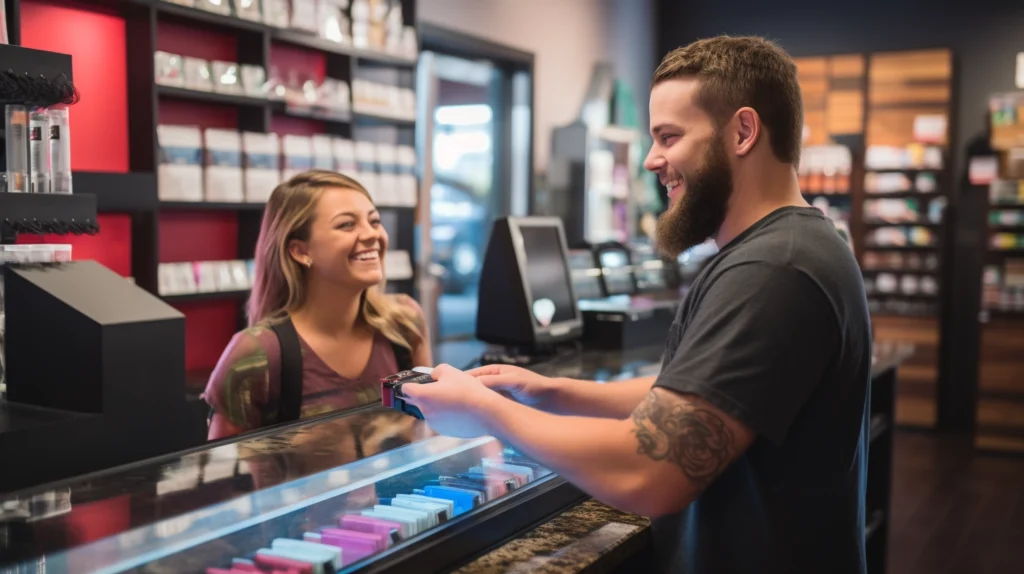
Laws and Regulations Concerning Sale of Vape Products to Minors
The sale of vape products to minors is a significant legal issue, governed by a variety of laws and regulations designed to prevent underage access to these products. Understanding these legalities is crucial for retailers, parents, and the community at large. Here’s an overview of the key aspects of these laws and regulations:
Federal Regulations:
- Minimum Age Requirement: In the United States, the federal law prohibits the sale of tobacco products, including vape products, to anyone under the age of 21. This law is enforced by the Food and Drug Administration (FDA).
- ID Verification: Retailers are required to verify the age of purchasers by checking a government-issued ID for anyone under the age of 21.
- Marketing Restrictions: The FDA also imposes strict regulations on the marketing of vape products to make them less appealing to minors. This includes restrictions on advertising in mediums that have a high youth audience.
State and Local Laws:
- Additional Restrictions: Many states and localities have enacted their own laws that can be more restrictive than federal regulations. For example, some states have banned flavored vaping products, which are particularly appealing to minors.
- Licensing Requirements: Some states require retailers to obtain a license to sell vaping products, and this license can be revoked if they are found selling to minors.
Penalties for Violation:
- Fines and Legal Consequences for Retailers: Retailers who sell vape products to minors can face significant fines. Repeated violations can lead to more severe penalties, including the possibility of criminal charges or the loss of their license to sell tobacco products.
- Penalties for Minors: In some jurisdictions, minors who purchase or attempt to purchase vaping products can also face penalties, such as fines or mandatory participation in educational programs.
Online Sales Regulations:
- Age Verification: Online retailers are required to verify the age of customers. This often involves more stringent checks than in-person sales.
- Shipping Restrictions: There are also regulations on how vaping products can be shipped, particularly to ensure that they do not end up in the hands of minors.
Enforcement Efforts:
- Compliance Checks: Regular compliance checks are conducted to ensure that retailers adhere to these laws. These checks are often carried out by law enforcement or regulatory agencies.
- Community Efforts: Local communities and schools often collaborate in education and enforcement efforts to reduce the sale of vape products to minors.

Latest News Updates Concerning Underage Vaping Laws
The landscape of laws concerning underage vaping is continually evolving as lawmakers respond to new research and trends in youth vaping. Here are some of the most recent updates and changes in laws related to underage vaping:
1. Federal Developments:
- Enhanced FDA Regulations: The U.S. Food and Drug Administration has recently tightened regulations on e-cigarettes and vaping products, particularly focusing on flavors that appeal to minors. The FDA is also increasing scrutiny on online sales to ensure robust age verification processes.
- Public Awareness Campaigns: The federal government has launched several public awareness campaigns aimed at educating young people about the dangers of vaping.
2. State-Level Changes:
- Flavor Bans: Several states, including New York and California, have implemented bans on flavored e-cigarettes, which are popular among teenagers. These bans are part of a broader effort to make vaping less appealing to young people.
- Increased Penalties for Sales to Minors: States like Texas and Florida have increased penalties for retailers caught selling vaping products to minors, including higher fines and potential loss of license.
- School-Based Programs: Many states have introduced or expanded school-based programs that focus on preventing underage vaping through education and intervention.
3. Local Ordinances:
- Vaping-Free Zones: Some cities have declared certain public areas, such as parks and near schools, as vaping-free zones to reduce exposure and accessibility to minors.
- Retail Restrictions: Local governments are increasingly imposing restrictions on where vaping products can be sold, with some requiring a minimum distance between vape shops and schools or playgrounds.
4. International Developments:
- Global Health Initiatives: Internationally, there are efforts led by organizations like the World Health Organization to combat underage vaping. Some countries have adopted stricter regulations, including complete bans on the sale of vaping products to minors.
- Age Verification Standards: Many countries are strengthening age verification laws for both in-person and online sales of vaping products.
5. Research and Studies:
- Ongoing Research: Continuous research is being conducted to understand the long-term effects of vaping, particularly on adolescents. This research is crucial in shaping future legislation and public health policies.
6. Industry Response:
- Self-Regulation: In response to these legal changes, some companies in the vaping industry have started self-regulating by discontinuing certain flavors and tightening their own age verification processes.
The Role of the Internet in Access to Vape Products
The internet has significantly impacted the availability of vape products, particularly concerning minors’ access. While online shopping offers convenience and a wider selection of products, it also presents challenges in enforcing age restrictions and preventing underage sales. Here’s an overview of how online access affects the availability of vape products to minors:
1. Ease of Access:
- Wide Availability: The internet provides easy access to a vast array of vaping products, from devices to e-liquids, often with fewer restrictions than physical retail stores.
- Anonymity and Convenience: Online shopping can be done anonymously and discreetly, making it appealing to minors who want to bypass in-person age verification.
2. Challenges in Age Verification:
- Loopholes in Online Verification: While legitimate online vape retailers are required to verify the age of their customers, the effectiveness of these measures can vary. Some websites may have lax verification processes, making it easier for minors to purchase vaping products.
- Third-Party Sellers: The presence of third-party sellers on large online platforms can further complicate age verification efforts, as these sellers may not adhere to the same standards as direct retailers.
3. Marketing and Promotion:
- Targeted Advertising: Online platforms enable targeted advertising of vaping products, often reaching a young audience. Social media, in particular, can expose minors to vaping-related content, including promotions and influencer endorsements.
- Social Media Influence: The portrayal of vaping on social media platforms can glamorize its use, influencing minors’ perceptions and potentially encouraging them to start vaping.
4. Regulatory Efforts:
- Stricter Regulations: In response to these challenges, governments and regulatory bodies are implementing stricter controls on the online sale of vape products. This includes enhanced age verification processes and restrictions on marketing practices.
- Monitoring and Enforcement: There is increased monitoring of online retailers and marketplaces to ensure compliance with underage sales laws. Violations can result in fines and legal action.
5. Parental Control and Education:
- Awareness and Monitoring: Parents play a crucial role in monitoring their children’s internet use and educating them about the risks of purchasing and using vape products.
- Use of Parental Control Software: Utilizing parental control software can help restrict access to websites selling vaping products and limit exposure to vaping-related content.

Support and Resources for Parents of Teens Who Vape
Discovering that your teen is vaping can be concerning for any parent. Fortunately, there are numerous resources and support systems available to help parents navigate this challenge. These resources provide guidance on how to talk to your teen about vaping, understand the risks involved, and find the appropriate support for helping them quit. Here’s a list of valuable resources and support systems for parents:
1. Educational Websites and Hotlines:
- The Centers for Disease Control and Prevention (CDC): Offers comprehensive information on the risks of vaping and tips on how to discuss vaping with teenagers.
- The Truth Initiative: Provides resources specifically aimed at helping teens quit vaping, including a text-to-quit program.
- Smokefree Teen (part of the National Cancer Institute): Offers a variety of tools and tips for teens trying to quit smoking or vaping, including a smartphone app.
2. Counseling and Treatment Programs:
- Local Health Departments: Many local health departments offer resources and programs for teens who vape, including counseling and treatment referrals.
- Substance Abuse and Mental Health Services Administration (SAMHSA): Can provide referrals to local treatment facilities, support groups, and community-based organizations specializing in adolescent substance abuse.
3. Online Forums and Support Groups:
- Parent Support Groups: Online platforms like Facebook and Reddit have support groups where parents can share experiences, advice, and support each other.
- Online Counseling Services: Services like BetterHelp and Talkspace offer online counseling for teens and their families, which can be a convenient way to access professional help.
4. Educational Materials and Guides:
- American Lung Association: Offers a wide range of materials on vaping, including an educational guide for parents.
- Partnership to End Addiction: Provides free downloadable resources that help parents understand vaping and how to talk about it with their children.
5. School-Based Programs:
- Consult School Counselors: School counselors can provide support and resources for addressing vaping and may facilitate access to school-based programs or interventions.
- Peer Education Programs: Some schools have peer education programs where students are trained to educate their peers about the risks of vaping.
6. Medical Professionals:
- Pediatricians and Family Doctors: Healthcare providers can offer advice on the health risks of vaping and provide referrals to cessation programs and specialists if needed.
7. Books and Literature:
- Informative Books: There are several books available that offer insights into teen vaping and strategies for parents, such as “The Vaping Fix” by Erika Edwards.
8. Government and Nonprofit Initiatives:
- FDA’s “The Real Cost” Campaign: Focuses on educating youth about the dangers of e-cigarettes and vaping.
- Campaign for Tobacco-Free Kids: Advocates for policies that reduce tobacco use and provides resources for parents and educators.

Laws Comparison: Vaping vs Smoking for Minors
The legal treatment of vaping and smoking for minors has become an important topic as vaping grows in popularity, especially among the youth. While both activities are regulated, there are nuances in how the law treats each, particularly for minors. Here’s a comparison of the legal landscape for vaping and smoking among underage individuals:
1. Age Restrictions:
- Vaping: In the United States, the federal minimum age to purchase vaping products is 21, following the Tobacco 21 law. This age restriction is consistent with the purchase of traditional tobacco products.
- Smoking: Similarly, the legal age to buy traditional tobacco products, including cigarettes, is 21. This uniformity in age restriction reflects a broad approach to prevent all forms of nicotine addiction in minors.
2. Sales and Marketing Regulations:
- Vaping: Vaping products are subject to strict marketing regulations to reduce their appeal to minors. This includes restrictions on advertising in mediums popular with youth and the prohibition of certain flavored products that are attractive to younger users.
- Smoking: Traditional tobacco products also face stringent marketing restrictions. There are bans on advertising on television, radio, and, in many areas, near schools. The packaging of cigarettes must include health warnings.
3. Penalties for Violation:
- Vaping: Retailers who sell vaping products to minors can face significant fines and the potential loss of their license to sell tobacco products. In some jurisdictions, minors caught possessing or using vape products may face fines or be required to attend educational programs.
- Smoking: The penalties for selling cigarettes to minors are similar, including fines and the possibility of losing a license to sell tobacco. Minors caught with cigarettes can also face fines and mandatory participation in cessation programs.
4. Public Use Restrictions:
- Vaping: Many states and localities have included e-cigarettes and vaping devices in their smoke-free laws, prohibiting their use in public places like restaurants, bars, and workplaces.
- Smoking: There are widespread restrictions on smoking in public places, often more extensive and strictly enforced compared to vaping.
5. Online Sales:
- Vaping: Online sales of vaping products require rigorous age verification processes to prevent sales to minors. This area has seen increased regulation in recent years.
- Smoking: The sale of traditional tobacco products online is also regulated, with strict age verification requirements to prevent purchases by minors.
6. Educational and Preventive Measures:
- Vaping: There is a growing emphasis on educational campaigns specifically targeting the risks of vaping for minors.
- Smoking: Long-standing public health campaigns and educational programs have been in place to discourage smoking among youth, highlighting the health risks associated with tobacco use.

Conclusion: Staying Informed and Keeping Safe
In addressing the complex issue of underage vaping, it’s clear that a multifaceted approach is necessary to effectively tackle this challenge. The key points discussed in this guide highlight the importance of staying informed and proactive, whether you’re a parent, educator, lawmaker, or a member of the community. Here’s a summary of the crucial aspects:
- Legal Age and Regulations: The legal age for purchasing and using vaping products is set at 21 in the United States, aligning with the age restrictions for traditional tobacco products. This uniformity is crucial in preventing nicotine addiction among minors.
- Penalties and Enforcement: There are significant penalties for both retailers selling vape products to minors and, in some cases, for the minors themselves. These range from fines to mandatory educational programs, emphasizing a focus on prevention and education over punitive measures.
- Health Risks: Vaping poses substantial health risks, especially to adolescents whose brains and bodies are still developing. These include nicotine addiction, respiratory issues, and potential long-term cardiovascular and mental health problems.
- Role of Schools and Parents: Schools and parents play a vital role in preventing underage vaping through education, policy enforcement, and support. Open communication, awareness programs, and counseling are key components of this effort.
- Influence of the Internet: The internet has made access to vaping products easier for minors, presenting challenges in age verification and regulation. Parents and authorities need to be vigilant in monitoring online activities and purchases.
- Community and Governmental Efforts: Community involvement and governmental initiatives, including public awareness campaigns and stricter regulations on sales and marketing, are essential in curbing underage vaping.
- Resources and Support: A wealth of resources and support systems are available for parents and teens. These include educational websites, treatment programs, and community support groups, all aimed at preventing and addressing underage vaping.

FAQ: Can You Go to Jail for Vaping at 13?
Q: Can a 13-year-old go to jail for vaping?
A: It is highly unlikely for a 13-year-old to be sent to jail for vaping. While vaping under the legal age is illegal, the legal system typically focuses on education and rehabilitation rather than incarceration for such offenses, especially for young adolescents.
Q: What are the legal consequences for a minor caught vaping?
A: The consequences for a minor caught vaping can include school disciplinary actions (like suspension), participation in educational programs about the risks of vaping, fines, and in some cases, involvement with the juvenile justice system in a non-incarceratory capacity, such as probation.
Q: Are there any legal penalties for selling vape products to a 13-year-old?
A: Yes, there are significant legal penalties for selling vape products to anyone under the age of 21, including fines and the potential loss of a license to sell tobacco products. In some cases, criminal charges may also be filed.
Q: Can parents be held responsible if their 13-year-old child is caught vaping?
A: While parents are generally not held legally responsible if their child is caught vaping, they are often involved in the resolution process, such as attending meetings with school officials or ensuring their child participates in required educational programs.
Q: What should a parent do if they discover their child is vaping?
A: Parents should address the issue calmly and constructively. It’s important to educate the child about the health risks of vaping, set clear expectations and consequences, and seek additional resources or professional help if necessary.
Q: Are the laws regarding vaping the same everywhere?
A: No, laws regarding vaping can vary by state and locality. While the federal minimum age for purchasing vaping products is 21, states and local governments may have additional regulations, particularly regarding flavors and public use.
In summary, while a 13-year-old is unlikely to face jail time for vaping, there are various other consequences and interventions that can be applied, focusing more on education and prevention. Parents play a crucial role in guiding and educating their children about the risks of vaping.
- The Dangers and Consequences of Using Fake IDs - April 26, 2024
- Can You Go to Jail for Vaping at 13? - January 4, 2024
- What Happens If You Are Caught Vaping Under 18? - January 4, 2024
